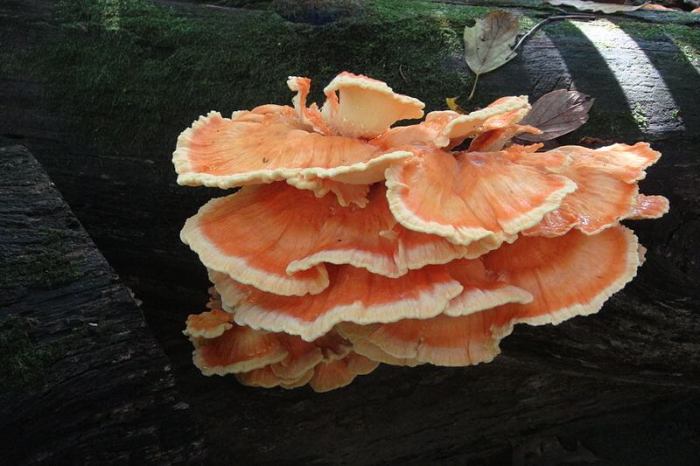
Welcome to the fascinating world of chicken of the woods recipe! This vibrant mushroom offers a delectable taste of the wild, inviting you on a culinary adventure. Whether you’re a seasoned forager or a curious cook, this guide will equip you with the knowledge and techniques to identify, prepare, and savor this extraordinary fungus.
Chicken of the woods boasts a unique appearance, nutritional value, and culinary versatility. Its bright orange color and succulent texture make it a standout in the forest, while its rich flavor and health benefits make it a welcome addition to any kitchen.
Chicken of the Woods Identification and Characteristics

Chicken of the woods is a large, brightly colored mushroom that is commonly found in forests throughout North America and Europe. It is a polypore fungus, which means that it has a porous surface instead of gills. Chicken of the woods is a popular edible mushroom, and it is often used in soups, stews, and other dishes.
Chicken of the woods is typically orange or yellow in color, and it has a fleshy, firm texture. It can grow to be quite large, with some specimens reaching up to 12 inches in diameter. Chicken of the woods is often found growing on dead or dying hardwood trees, and it is most common in the fall.
Varieties of Chicken of the Woods
There are several different varieties of chicken of the woods, each with its own unique characteristics. The most common variety is the Laetiporus sulphureus, which is found in North America and Europe. This variety is typically orange or yellow in color, and it has a firm, fleshy texture.
Have you ever wanted to try a unique and delicious mushroom dish? If so, look no further than the chicken of the woods recipe . This edible fungus is known for its bright orange color and meaty texture, making it a perfect substitute for chicken in various dishes.
Whether you’re a seasoned cook or just starting out, this recipe is sure to impress your taste buds.
Another common variety is the Laetiporus cincinnatus, which is found in North America. This variety is typically yellow or white in color, and it has a softer, more delicate texture.
Habitat and Distribution
Chicken of the woods is found in forests throughout North America and Europe. It is most common in deciduous forests, and it is often found growing on dead or dying hardwood trees. Chicken of the woods is a saprobic fungus, which means that it gets its nutrients from decaying organic matter.
It is often found growing on the trunks of trees, and it can also be found growing on fallen logs and stumps.
Nutritional Value and Health Benefits

Chicken of the woods boasts an impressive nutritional profile, making it a valuable addition to any diet. It is an excellent source of dietary fiber, essential for maintaining a healthy digestive system and promoting satiety. Moreover, it is low in calories and fat, making it a suitable choice for those seeking weight management.
Antioxidant and Anti-inflammatory Properties
Chicken of the woods is rich in antioxidants, which help protect cells from damage caused by free radicals. These antioxidants include ergothioneine, a unique amino acid with potent antioxidant effects. Additionally, chicken of the woods contains anti-inflammatory compounds that may alleviate symptoms associated with inflammatory conditions such as arthritis and asthma.
Role in Traditional Medicine
Chicken of the woods has been used in traditional medicine for centuries. In Traditional Chinese Medicine, it is believed to strengthen the immune system and improve overall well-being. Additionally, some Native American tribes used it to treat wounds and infections.
Culinary Applications

Chicken of the woods is a versatile culinary mushroom that can be used in various dishes. It has a meaty texture and a slightly nutty flavor that makes it a great substitute for chicken in many recipes.
Chicken of the woods can be cooked in various ways, including sautéing, roasting, grilling, and frying. It can also be used in soups, stews, and casseroles. The flavor and texture of the mushroom will vary depending on the cooking method used.
Cleaning and Preparing
Before cooking chicken of the woods, it is important to clean it properly. The mushroom should be brushed to remove any dirt or debris. It should then be cut into small pieces.
Cooking Methods
- Sautéing:Sautéing is a quick and easy way to cook chicken of the woods. The mushroom should be sautéed in a pan with a little bit of oil until it is browned and tender.
- Roasting:Roasting is another great way to cook chicken of the woods. The mushroom should be roasted in a preheated oven at 400 degrees Fahrenheit for about 20 minutes, or until it is browned and tender.
- Grilling:Grilling is a great way to cook chicken of the woods if you want to give it a smoky flavor. The mushroom should be grilled over medium heat for about 10 minutes per side, or until it is browned and tender.
- Frying:Frying is a delicious way to cook chicken of the woods. The mushroom should be fried in a pan with a little bit of oil until it is golden brown and crispy.
Flavor Profiles
The flavor of chicken of the woods will vary depending on the cooking method used. Sautéed chicken of the woods has a slightly nutty flavor, while roasted chicken of the woods has a more earthy flavor. Grilled chicken of the woods has a smoky flavor, and fried chicken of the woods has a crispy, flavorful crust.
Textures
The texture of chicken of the woods will also vary depending on the cooking method used. Sautéed chicken of the woods has a tender, chewy texture, while roasted chicken of the woods has a more firm texture. Grilled chicken of the woods has a slightly crispy texture, and fried chicken of the woods has a crispy, crunchy texture.
Storage and Preservation
Proper storage and preservation techniques are crucial for maintaining the freshness and quality of chicken of the woods. Fresh chicken of the woods should be refrigerated immediately after harvest to prevent spoilage. Cooked chicken of the woods can also be refrigerated or frozen for longer storage.
Fresh chicken of the woods has a relatively short shelf life. It should be consumed within a few days of harvesting. Cooked chicken of the woods can be stored in the refrigerator for up to 3 days or frozen for up to 3 months.
Freezing
Freezing is an effective method for extending the shelf life of chicken of the woods. To freeze chicken of the woods, cut it into small pieces and place it in an airtight container or freezer bag. Frozen chicken of the woods can be stored for up to 3 months.
For those interested in exploring the versatility of chicken of the woods, I recommend consulting this comprehensive chicken of the woods recipe guide. It provides detailed instructions and helpful tips for preparing this delicious mushroom in various forms, including stir-fries, pizzas, and even vegan “chicken” nuggets.
Drying
Drying is another method for preserving chicken of the woods. To dry chicken of the woods, cut it into thin slices and place it on a drying rack in a warm, dry place. The chicken of the woods should be dried until it is completely brittle.
Dried chicken of the woods can be stored in an airtight container for up to 6 months.
Pickling
Pickling is a method for preserving chicken of the woods in a vinegar solution. To pickle chicken of the woods, cut it into small pieces and place it in a jar with a vinegar solution. The chicken of the woods should be pickled for at least 2 weeks before it is ready to eat.
If you’re looking for a unique and flavorful culinary adventure, check out this chicken of the woods recipe . This edible mushroom, known for its vibrant orange hue and earthy flavor, can be prepared in a variety of ways. Whether you sauté it, grill it, or add it to soups and stews, it’s sure to tantalize your taste buds.
Pickled chicken of the woods can be stored in the refrigerator for up to 6 months.
Foraging and Cultivation

Chicken of the woods can be found in various forests worldwide, typically growing on the base or stumps of oak trees. Identifying and foraging for this mushroom in the wild requires knowledge of its unique characteristics. It’s crucial to approach foraging responsibly, considering ethical and environmental implications.
Cultivating chicken of the woods involves replicating its natural growth conditions, presenting challenges but also opportunities for controlled production. This section delves into the techniques and considerations involved in both foraging and cultivating this delectable mushroom.
Foraging for Chicken of the Woods
Foraging for chicken of the woods requires keen observation and an understanding of its distinct features. It typically appears in clusters or shelves on the base or stumps of oak trees. The mushroom has a bright orange to yellow coloration, with a velvety texture and a slightly fruity aroma.
When foraging, it’s essential to avoid mushrooms that exhibit signs of damage or decay.
Ethical and Environmental Considerations
Ethical and environmental considerations should guide responsible foraging practices. Respecting the natural ecosystem is paramount, and it’s crucial to avoid overharvesting or damaging the environment. It’s recommended to harvest only what is needed and leave ample behind for the mushroom to reproduce and sustain the ecosystem.
Cultivating Chicken of the Woods, Chicken of the woods recipe
Cultivating chicken of the woods requires specialized techniques and a controlled environment. One common method involves inoculating logs or substrates with mushroom spawn. The inoculated logs are then placed in a shaded, humid environment, mimicking the natural conditions in which the mushroom grows.
Maintaining optimal temperature, humidity, and aeration is essential for successful cultivation.
Ending Remarks

From identifying chicken of the woods in the wild to preserving its freshness, this guide has provided a comprehensive overview of this culinary treasure. With a little practice and a touch of curiosity, you’ll be able to forage, cook, and enjoy chicken of the woods like a seasoned pro.
So, let’s venture into the woods and uncover the secrets of this delectable mushroom!
FAQ Overview: Chicken Of The Woods Recipe
Can chicken of the woods be eaten raw?
No, chicken of the woods should not be consumed raw. It contains a compound that can cause stomach upset if not properly cooked.
How long can chicken of the woods be stored in the refrigerator?
Fresh chicken of the woods can be stored in the refrigerator for up to 5 days. Cooked chicken of the woods can be stored for up to 3 days.
Is chicken of the woods a good source of protein?
Yes, chicken of the woods is a good source of protein, providing approximately 10 grams per 100-gram serving.






